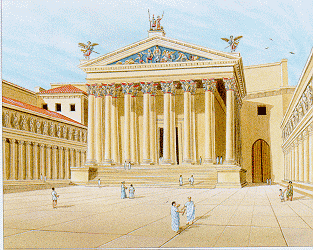By the end of the 1st century Rome had grown astronomically. The government needed to adapt to this growth and it was Augustus who sought to undergo this project. He divided Rome into 14 administrative regions, each under an appointed magistrate, employed a police force and fire brigade, and built or restored several aqueducts. To prevent flooding he had the River Tiber dredged and widened. Thoughtfully, Augustus took personal responsibility for the corn dole, the monthly distribution of free grain to the city's poor.
Augustus also spent an elephantine amount of money on the expansion of the city, making it fit to be the capital for so great and empire. He exclaimed that he had found Rome brick and left it marble, and this claim was not without basis. He managed to create many new structures to serve as offices, law courts and other administrative activities. Augustus was assisted by members of his family and by trusted friends and colleagues such as Statilius Taurus and above all Marcus Agrippa. North of the city, near the Campus Martius region, Agrippa was responsible for a chain of buildings such as the original Pantheon, the Baths of Agrippa and the Saepta Julia. Further north, Augustus erected an enormous sundial, the Horologium, with an obelisk brought from Egypt as its pointer. Nearby the circular Mausoleum, which held ashes of Augustus when he was laid to rest in AD 14, was built.














